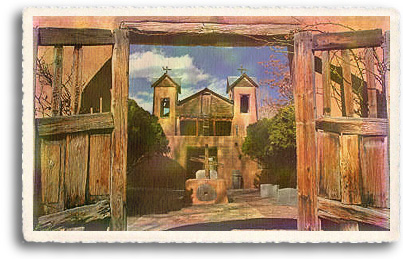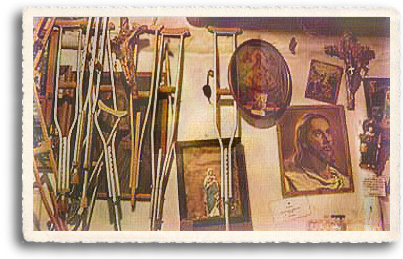 |
||
The Miracle of El Santuario de Chimayo  Despite its rather remote location in the hills surrounding the tiny village of Chimayo, the legendary shrine el Santuario de Chimayo is probably the most visited church in New Mexico. Known as the Lourdes of America, the Santuario is a tiny chapel and shrine believed to be built on sacred earth with miraculous healing powers based on a miracle associated with the crucifix of "Nuestro Señor de Esquipulas" (Our Lord of Esquipulas). El Santuario de Chimayo is also the site of "el pocito," a small pit of Holy Dirt which many believe to possess remarkable curative powers. There are many stories about the miracle that led to the building of the Santuario. The most common tells of a villager named Bernardo de Abeyta, who was a Penitente, the brotherhood that kept the Catholic faith alive in New Mexico when priests were few. On Good Friday, in 1810 or 1811, Abeyta was performing the rituals of penance when he saw a light bursting forth from a nearby hillside. Upon digging at the source of the light, he found a large crucifix, which he called the Miraculous Crucifix of Our Lord of Esquipulas. A Home for a Sacred Artifact Bernardo de Abeyta and other Chimayo villagers formed a procession to carry the crucifix to the nearest church, 8 miles away in Santa Cruz. But the next day the crucifix was missing from the altar,  to be found back in its original place in the hills of Chimayo. The procession was repeated two more times before it became clear that el Señor de Esquipulas wanted to remain in Chimayo, thus prompting the building of the original small chapel on that site. Then the miraculous healings began, growing so numerous that the chapel had to be replaced by the larger adobe mission which is the current Chimayo shrine. Named el Santuario de Nuestro Señor de Esquipulas, the shrine was finished in 1816, and is now commonly known as el Santuario de Chimayo. to be found back in its original place in the hills of Chimayo. The procession was repeated two more times before it became clear that el Señor de Esquipulas wanted to remain in Chimayo, thus prompting the building of the original small chapel on that site. Then the miraculous healings began, growing so numerous that the chapel had to be replaced by the larger adobe mission which is the current Chimayo shrine. Named el Santuario de Nuestro Señor de Esquipulas, the shrine was finished in 1816, and is now commonly known as el Santuario de Chimayo.There are many testimonies of extraordinary miracles of healing, and in time, word spread of the miracles of el Santuario de Chimayo. Now close to 300,000 people come to the Santuario each year. They come to worship the Almighty, to ask for peace in the world and in their hearts, to fulfill a promise, and to feel the healing touch of God. According to the legends of neighboring Tewa Indians, the spot where the crucifix had been found had been sacred to various Indian tribes for generations. Originally a spring had bubbled up there, rich in iron and other minerals. When the spring dried up, they still came for the dirt and for healing. Territorial and other disputes between tribes were laid aside at the sacred site. The church itself is a beautiful example of adobe architecture at its finest, full of odd angles of wood and unusual details which point to the loving hands which built it. Both the church and the towers which flank it were originally flat-topped. The pitched roof and pitched-roof wooden caps which finish off the towers were added in the 1920s.  A Visit to El Santuario de Chimayo Through a gated archway visitors enter a small courtyard which leads to the carved wooden doors of the church itself. Once inside, the walls are lined with reredos, brightly painted wooden screens portraying various saints. Here also are bultos, or statues, of saints. A small bulto on the altar is a depiction of Santiago (Saint James) on horseback, to whom the Christians prayed in their fights against the Moors. In earlier times, pilgrims would leave tiny handmade boots, spurs, and halters for Santiago. "El Pocito," the little well of holy dirt, is located in a small room next to the sanctuary, first to the left of the altar, through a little passageway, then to the right, through a doorway so short, even those who are barely 5' tall must duck to enter. Dirt can be collected in a baggie, or can be purchased in small containers from one of the little shops nearby. Beyond this room is a testament to the miracles of el Pocito and the Santuario, a small room completely filled with the crutches, handmade rosaries, before-and-after photographs, and gifts left behind by those who have been healed. Located a short walk from el Santuario is a shrine to the Santo Niño de Atocha. Considered a manifestation of Jesus as the Holy Child, the Santo Niño has a long history of ministering to the imprisoned, the sick and the poor. The chapel is built in traditional Northern New Mexico architecture, its adobe walls spanned by large vigas. Recently renovated, the chapel is now filled with art and Spanish colonial furniture. In a small prayer room adjoining the chapel itself is a large wooden bulto of the Santo Niño de Atocha, traditionally depicted with a basket of bread and a water gourd hanging from his staff. The Santo Niño is said to wander the nearby hills at night, spreading miracles and wearing out his little shoes. Lying at his feet on the altar are shoes left for him by visitors to the chapel, left as entreaty or as thanks for prayers answered. During World War II, many soldiers from New Mexico were stationed in the Phillipines because of their fluency in Spanish. Throughout the long siege of Corregidor and the Bataan Death March which followed, many New Mexican soldiers, some suffering internment in Japanese prison camps, prayed to the Santo Niño de Atocha, and many believed that they were spared as a result of his intervention. After the war ended, 2,000 New Mexico servicemen made a pilgrimage to the Santuario, some barefoot, to give thanks to the Santa Niño.  A Tradition of Faith A Tradition of FaithThis began the annual Easter tradition of walking to el Santuario de Chimayo in honor of the Santo Niño de Atocha, to offer thanks for their deliverance, and in memory of those who were lost during the Bataan Death March. In 1956, the Shrine of Santa Niño de Atocha was built, and the tradition of the Easter pilgrimage to Chimayo has continued to flourish. That tradition has now grown to encompass tens of thousands of individuals of all faiths and all walks of life. Every year during Holy Week, in the darkness before Good Friday, pilgrims line the highways north of Santa Fe, carrying crosses and candles. By Easter Sunday tens of thousands of worshipers pass through the doors of the el Santuario, taking away with them a bit of the sacred dirt. They come from Santa Fe and Albuquerque and many other destinations, walking 10, 20, 30, or even 100 miles or more to reach el Santuario de Chimayo. The crucifix for which the original shrine was built still resides on the chapel altar, but its curative powers have been overshadowed by el Posito, the "sacred sand pit" from which it sprang. Many who have made the pilgrimage claim to have been cured there of diseases, infirmities and unhappiness, with the walls of the sacristy standing in testament to the healing of the faithful. El Santuario de Chimayo is open 9:00 - 5:00 during the winter months and 9:00 - 6:00 during the summer. More about Chimayo Back to Multi-Cultures |
||
Home | Food | Lodging | Merchants | Services | Real Estate | Art & Galleries | Entertainment | Recreation Ski Areas | Mind-Body-Spirit | Taos Information | Local Color | Taos Pueblo | High Road to Taos | Taos Plaza | Ranchos de Taos Scenic Beauty | Day Trips | Chili | Special Events | Taos History | Multicultures | Museums | The Enchanted Circle The Wild West | Taos Art Colony | Plants & Wildlife | Counterculture | Turquoise | Architecture | Features | About Us |Get Listed! Taos Unlimited Trading Post | Photo of the Week | Link of the Month | Taos Webcams |Taos Weather | Testimonials | Guestbook Taos A to Z | Movie Locations |Sitemap | Taos Unlimited Blog | Aimee & Jean's Story Blog | Contact Us | Santa Fe Unlimited |
||